 |
|
|
 |
||
MONK SEAL MYTHS IN SARDINIA
William M. Johnson

Picture Postcard ~ Welcome to the Grotto of the Sea Ox
 |
|
|
 |
||
MONK SEAL MYTHS IN SARDINIA
William M. Johnson

Picture Postcard ~ Welcome to the Grotto of the Sea Ox
Myths and legends have coloured the history of the Mediterranean monk seal since ancient times, but it’s in the late 20th century that they assume a peculiar new twist. While potent superstitions once tested the credulity of village folk, it’s in these allegedly more rational times that gullibility meets free enterprise in a mass marketplace.
Welcome to Sardinia. As factories and businesses across Italy close down for the traditional August break, the ranks of the foreign tourist contingent are suddenly swelled by battalions of Italian holidaymakers, all heading for the beach. It’s an invasion of unparalleled proportions, with convoys of planes, ships, buses and cars delivering them to the front. Within days, coastal resorts are bursting at the seams, and tourists are skirmishing over the few empty slots on the beach or a table that suddenly becomes vacant in a jam-packed restaurant.
Many will head for the Costa Smeralda, north of Olbia, whose rugged natural features were given a concrete facelift by the Aga Khan. Legend has it that the spiritual leader of the Ismaili Muslims was caught in a violent storm hereabouts, and sought shelter in a nearby cove. Surveying the coast from his luxury yacht, he was reputedly so impressed by the area’s pristine beauty that he was struck by a sudden vision, mainly consisting of luxury villas for the rich and famous, hotels and nightclubs (Owen 1997). And the rest, as they say, is history.
The once-lonely eastern shores of the island were also ripe for the picking by other speculators. Many set their sights on the Gulf of Orosei, with its turquoise waters and white sands. South of the thriving resort town that bears the same name, the landscape becomes more dramatic, the coast dominated by limestone cliffs, sandy coves, and maquis slopes of stunted pines, juniper, laurel and aromatic herbs. Here and there, watery ravines cut down to the sea from the bare-backed mountains beyond, the river beds engulfed by red oleander. Along the craggy coastline, great arching caves, once home to families of seals, tunnel their way into the cliff-face. For all its wild beauty, the area is afflicted by a kind of split personality, inundated by tourists during the high season summer months, and reverting to its innate loneliness for the rest of the year.
From the Sardinian hinterland, a single road tunnels through the grey mountains and then serpentines its way down to the bustling resort of Cala Gonone. In tourist brochures, it’s touted as a quaint little fishing village, and if that was the extent of the deception, one might be tempted to pass it off as one of those less endearing traits of the modern world, where image has become a far more valuable commodity than substance. Faded black and white photos from the 1920’s provide a mute testament to the community’s former reclusive self, when only twenty or so houses were nestled on a single bluff overlooking the sea.
Today, aside from a couple of trawlers and a few small purse-seiners, fishing scarcely plays a role at all in the life of this village that has grown into a town. Instead, hotels, apartments and summer houses have claimed the hillside in an urban sprawl, complemented by bars, pizzerias and the inevitable gimcrack souvenir shops. Down at the waterfront, the harbour is so jammed with speedboats, inflatables, dinghies and sailing skiffs, that owners must employ hooks, hands and feet if they are to have any hope of ever reaching the open sea.
Cala Gonone’s main claim to fame is the Grotta del Bue Marino, the grotto of the sea ox, lying about three kilometres south of the town.
Monk seals have long played a role in the life of the community and continue to do so to this very day. Even as late as the 1950’s, hunters and shepherds were still shooting seals, mostly to turn their pelts into leather shoes and belts. Fishers also waged war against the species, driven by an age-old hostility. Even so, as many as 30 seals still clung tenaciously to survival in the Gulf of Orosei during this period (Ardizzone et al. 1991). Colonies inhabited the Grotto of the Sea Ox, whose waterways, tunnels and inner caverns burrow into the limestone cliffs for several kilometres, and also similarly impressive caves further south, that can only be accessed by skilled divers and potholers.
To the tourist hordes that swell the town during summer, there would seem to be more seals here than anywhere else. Seals can be found in the souvenir shops, staring out at you from postcards, posters, T-shirts and baseball caps. Seals appear in promotional leaflets and guidebooks, most quite shamelessly raising hopes of a chance encounter with the species at the famous Bue Marino. Plush seal toys lie appealingly in wicker baskets, awaiting new owners. Seals are embossed on the ceramic tiles that mark the village’s roads, and are painted onto the huge metal signs marking the camp site. Last, but not least, even official recognition has been bestowed upon the seal, its image forming the community’s emblem, the civic equivalent of a corporate logo. In short, Cala Gonone boasts a veritable plethora of seals. Appearances, of course, can be deceptive, and the first clue that something might be amiss lies precisely in these multiple seal images dotted about the town. Few, if any, bear any resemblance to the monk seal at all. Most, in fact, appear to be the works of caricaturists who could not even be bothered to acquaint themselves with Monachus. Predictably, the inevitable result is a kind of Disneyesque circus sea lion.
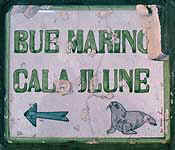
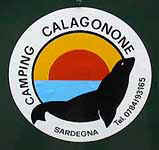
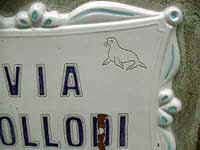
Not to be left out of the seal-selling stampede, the World Wide Fund for Nature (WWF) has marked its presence with a small kiosk among the ticket booths at the harbour and, in the upper reaches of the town, has opened up a conservation centre, inevitably christened Centro Bue Marino. Here, volunteers sell merchandise, hand out leaflets and solicit donations for the monk seal’s conservation. Visitors are also treated to video screenings of the seal’s life in the wild. While the accompanying narration might be explicit enough, it must be open to question whether the tourists, wilting from the sun, and traipsing in and out in the middle of shows, even register the fact that these seals are not from the Grotto of the Sea Ox or anywhere else in Italy. Further cultivating the myth of Orosei seals are WWF bumper stickers, bearing an improbably smiling Monachus. These hail the organisation’s Operazione Bue Marino, a last-ditch effort to save an animal that even the WWF volunteers reluctantly admit no longer inhabits the area.
Faded black and white prints, pinned to exhibition panels, offer a truer picture of the monk seal’s fate at Orosei, and of the harsh reality that lurks behind well-cultivated myths of its continuing survival here. In one image, a hunter, rifle in hand, bandoleer slung across chest, poses proudly beside his catch, a huge adult seal slung vertically from a winch. In another print, a helmeted potholer wades through a waist-deep pool towards a startled pup.
Nearby, a series of grainy images records the unlucky adventures of another infant seal, captured by fishers at the Grotta del Bue Marino in December 1951. In the first picture, we see it struggling to emerge from the thick twine fishing net in which it was caught, its large round eyes seeming to convey astonishment rather than fear. Several curious faces pore over the little creature, among them, two strangers from Rome who had commissioned the capture. Wrapped up in woollen overcoats against the winter cold, the two men claimed to be journalists, though their reasons for acquiring the pup remain a mystery to this very day. Possibly, they hoped to sell it to a zoo or circus, or, acting on impulse alone, dreamed of causing a sensation in the streets of the capital. The events that followed, recorded for posterity in subsequent shots, rather suggest a preconceived stunt. Surrounded by a battery of press photographers, movie cameramen and curious onlookers, the two men can be seen releasing the pup in Rome’s famous Piazza di Trevi fountain. Here, it frolicked about in the water until policemen rushed to the scene.
The prank even caught the attention of the world’s press, The Times of London declaring:
"Passers-by in the Piazza di Trevi, the square whose main feature is the great fountain into whose waters every visitor who wishes to return to Rome must throw a coin, were astonished this morning to see a seal swimming in the basin. The animal was the property of two Roman journalists, who had brought it back from Sardinia and who apparently thought it suitable that the seal should have a swim in such famous surroundings. A literal-minded policeman fined them for contravening the by-law which prohibits the throwing of anything but money into the fountain, and they and the seal departed in a motor-car" (Anon. 1951).
Around the harbour in Cala Gonone, numerous signs and promotional displays beckon you to ticket booths touting trips to the famous Bue Marino cave and neighbouring sandy beaches. Each ticket bears a colour photo of this impressive arching cavern, and on the reverse side, a picture of a white-bellied newborn pup.
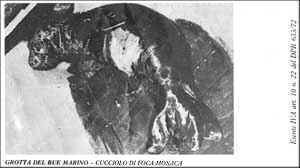
On the hour, every hour, tourists flock to the boats, tickets in hand, children in tow, packed lunches in knapsacks and coolers, cameras slung from necks. With many loaded down with beach paraphernalia as well, no one would dare accuse them of being ill-equipped for their expedition. Brimming with passengers, the tour boats set off, inflatables and water scooters skimming by, most, it seems, in a dash to stake claim on one of the beaches that will soon congeal with human bodies.
At the mouth of the Bue Marino, the boats await their turn to dock at the landing stage to disgorge or retrieve their passengers. Three at a time, they tie up under the arching roof and lower their gangplanks. The scene erupts in a chaos of roaring engines, billowing diesel fumes, hoarse staccato shouts from guides, deckhands and captains, hundreds of feet clattering over the aluminium gangways. The raw stone path leading deep into the bowels of the earth is crammed with people now, all talking ten to the dozen, and you may be forgiven for believing that you’ve just stumbled into one of the hellish images of Hieronymus Bosch.
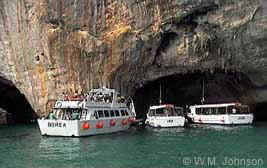
Trooping into a huge, dimly-lit cavern with a vaulted roof, the assembled crowds are assigned a tourist guide according to language and nationality. We find ourselves consigned to a motley group of Germans, under the command of a dour, bespectacled young woman who, in all fairness, can hardly be blamed for concluding that she is herding creatures marginally less intelligent than cattle.
A walk of a kilometre or more now awaits us, the rock-hewn path following the sinuous waterway, passing through one cavern after another, spotlights illuminating numerous dripping stalactites. Our destination, our guide informs us, is the innermost grotto where monk seals used to rest and give birth. Used to? Yes, she responds emphatically, a defiant, almost accusing look in her eye. Then comes the punch line: "Monk seals are very shy creatures, and their conservation is incompatible with tourism."
You can see some of the day-trippers eyeing their ticket stubs, the little pup staring back at them forlornly, wondering if they’ve been duped. An understandable suspicion, given all the hype. A glossy brochure, issued by the local community and handed out free to hotel guests, states that the famous Grotto "is lived in by the last of the monk seals…" (Associazione Turistica 1997). On the internet, the Italian Touring Club touts excursions to the Grotta del Bue Marino, "where seals can sometimes be seen" (Touring Club Italiano 1995). Even a brochure carrying the WWF logo is scarcely less economical with the truth: "In the Gulf of Orosei can sometimes be glimpsed the last exemplars of the Mediterranean monk seal, a species on the brink of extinction…" (ESIT/WWF 1997).
Just as we’re about to set off along the narrow walkway, our guide issues a stern warning that photography is strictly forbidden. Of course, everyone wonders why. Could the incessant flashes inflict damage upon the glittering stalactites, perhaps, cause tourist jams as dawdlers pause to take a snap or two, or even scare away the odd seal, venturing home despite the guide’s terse denials? But no. It transpires that photography is verboten for a reason rather less mundane, banished from the Grotto by mayoral executive order. By all accounts, this was not because of some last ditch effort to preserve habitat, but rather, to preserve global copyright. Not content with knowingly driving monk seals away from their homes and presiding over their extinction, the local community, by copyrighting the sea ox’s former habitat, now stood to make a killing of a more lucrative nature, collecting cash from exclusive royalty agreements with professional photographers and syndicates.
Despite the mayoral diktat, from the tail end of our group, flashes continue to strobe through the gloom, forcing our increasingly flustered guide to deliver another strident lecture to the unseen miscreants.
At long last, we file into the monk seal’s inner sanctum, still under the smouldering eyes of our guide, who has now cottoned on to the fact that the day-trippers have resorted to taking surreptitious snaps without the aid of their telltale flashes. Their efforts to reason with her fall on stony ground. "Flashes are not the issue," she berates us. "Photography of any kind is strictly forbidden."
As several groups converge, the great vaulted cavern is filled to capacity. An undulating bed of limestone slopes down gently into the inky black water, once home to a family of seals. But no more. Ghostly human figures stumble about aimlessly in the gloom, their tans lost to the pallid limestone, their chattering subdued now to echoing murmurs. It is a scene so effortlessly eerie and absurd that even the fable of Orpheus’ descent into the underworld no longer seems all that far-fetched. At any moment, one might expect the Ferryman to punt his way up the Styx. But today, at least, ferries of a rather different kind await us.
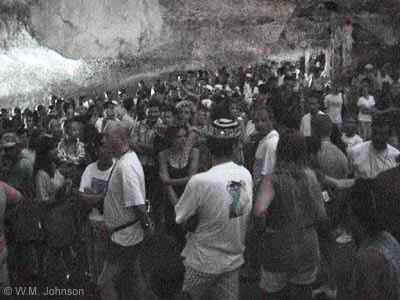
Boarding our respective tour boats, we head off to the crescent shores of Cala Luna, lying at the foot of a mountainous ravine, where the river forms a pond bordered by lush reeds and blossoming oleander. Across the sable sand, the crowds are so thick that one almost feels the need to slick oneself down with sun lotion to have any chance of squeezing through. At the northern edge of the beach, several impressive caves burrow into the limestone cliff-face. Seals almost certainly sought refuge from the sun here long ago, but today only herds of tourists loaf about under the yawning arches.
Some may claim that the monk seals of Orosei fell victim to the inevitable march of progress, that they became extinct by default rather than by any deliberate effort to eradicate the animals. While there is some truth to both sides, history is explicit in recording the local community’s hostility towards the conservation of the species, and its ultimately successful efforts to sabotage a short-lived marine reserve in the area.
When Cala Gonone was still a village, local people used to say that seals had lived in the Grotta del Bue Marino for as long as they could remember. Though persecuted by fishers, hunters and shepherds, the cave continued to harbour a small colony of 5-10 seals during the 1950s. With harassment and intrusion by tourists on the increase, however, numbers continued to dwindle, from four in 1962, to only a single pair in 1970. A year or so later, the sole surviving individual apparently fell victim to a local fisher, who resented his rival’s lucrative trade in ferrying tourists to observe the creature. At this time, the Grotto had already become a major tourist landmark, attracting some 15,000 visitors in 1970 alone (Scott 1972). Illustrating the lethal effects of disturbance – possibly combined with inbreeding – on the beach at the mouth of the Grotto, researchers discovered three aborted foetuses in 1965, and one each for the years 1967, 1968 and 1970 (Bareham & Furreddu 1975).
With some 40 grottoes in the Gulf of Orosei, seals continued to survive elsewhere, albeit in declining numbers. Mounting a thorough exploration of the coast, Antonio Furreddu, a Jesuit priest and keen amateur potholer, discovered a group of seals inhabiting another cavern, about two hundred metres south of the Bue Marino. This grotto offered far greater protection than its famous neighbour, with a subterranean channel, 10 meters underwater, leading to two inner lagoons surrounded by sandy, pebbly shores. Deterring all but the most adventurous explorers, these inner caverns could only be reached by divers using scuba gear, or by experienced climbers potholing down through a fissure in the cliff. An expedition led by Father Furreddu in October 1970 counted 6 seals around the lagoons, including a pup, and sighted another 1-2 animals swimming offshore (Scott 1972, Bareham & Furreddu 1975).
Local fishers at Cala Gonone, who in summer were supplementing their traditional incomes by ferrying tourists to the Bue Marino, denied any hostile intent towards the animals. Although the seals continued to damage their nets, they insisted that they had come to appreciate their value as a tourist attraction. Although there was some doubt about the veracity of their claims, it was already clear that the hordes of tourists had become a menace to the seal’s survival. Hunting also posed unquantifiable risks to the species. Although the killing of monk seals had been prohibited since 1939 (Marini 1994), hunters, mostly after other quarry, had turned the entire Orosei coastline into a shooting gallery (Scott 1972, Bareham & Furreddu 1975).
Reacting to both international and domestic pressure, in July 1987 a coastal zone south of Cala Gonone (between Foce Codula di Luna and Punta Pedra Longa) was declared a Special Protection Area, in which both fishing and general navigation were prohibited (Anselin & van der Elst 1987, UNEP/MAP 1988). Although Sardinia’s regional parliament had given its tacit blessing to the creation of marine reserves a year earlier, this new initiative was delivered by ministerial decree issued from Rome (Council of Europe 1986).
While the decree provided interim protection to the seals and their habitat, scientists and government officials had their eyes set on a more elegant solution, in which the marine sanctuary would be incorporated into the mountainous Gennargentu National Park, whose north-eastern perimeter touches the shores of Orosei (Anselin & van der Elst 1987, ESIT/WWF 1997).
Making hay while the sun continued to shine, the Ministry of Environment forged ahead with other initiatives, commissioning a management plan for the Gulf of Orosei, and funding public awareness campaigns and a sightings information network (UNEP/MAP 1988). In the meantime, however, the local weather had turned increasingly stormy. Claiming that the marine sanctuary would drive them out of business and send Cala Gonone reeling back into the Dark Ages, the tourist industry and local fishers joined forces to scuttle it. Faced with mounting hostility, the authorities in Rome finally caved in, rescinding the decree (Marini 1994).
Seeking clarification, we headed back to the WWF Centro del Bue Marino, where a somewhat confused volunteer told us that the monk seal reserve "was only administrative, not geographical." A fine choice of words, it seems, to convey the fact that it was never worth the paper it was written on. On some maps, the ill-fated marine sanctuary is still marked as the Riserva Naturale della Foca Monaca. On others, this particular stretch of coast is fancifully labelled the Costa del Bue Marino.
By the early 1990s, despite rare sporadic sightings, Monachus had been judged effectively extinct not only in the Gulf of Orosei but also elsewhere in Sardinia and Italy in general. As a final epitaph, efforts to conserve these scattered survivors – or vagrants from other areas – were characterised as being "doomed to failure" (Ardizzone et al. 1991, Marini 1994).
Unfazed, Cala Gonone continued to flog the proverbial dead horse for all it was worth. Seals, after all, had become the town’s main claim to fame, and nothing so inconsequential as the monk seal’s local extinction could be permitted to derail the fast track development of the resort.
The monk seal experience at Orosei might act as a cautionary tale to those who are still touting the utilitarian ideal that endangered species can be saved from extinction by according them an economic value in the marketplace. Cala Gonone, it could be said, can now enjoy the best of both worlds. Expediently forgetting its role in the monk seal’s demise, the village, much like Loch Ness, can cultivate the myth of the sea ox’s elusive, brooding presence, without all the tiresome inconvenience of establishing protected areas or putting lucrative caves and beaches out of bounds to a booming, conveyor-belt tourist industry. Unwittingly perhaps, it has invented the concept of sustainable use of extinct populations.
References
Anon. 1951. Seal in Famous Rome Fountain. The Times. London. 14 December, 1951.
Anselin, A., and M. van der Elst (eds.). 1987. Monk Seal Bulletin. No. 5. October 1987. Institut Royal des Sciences Naturelles de Belgique, Brussels. pp. 3.
Ardizzone, Giandomenico, Roberto Argano, and Luigi Boitani. 1991. Le déclin du phoque moine en Italie et sa survie dans un contexte méditerranéen. pp. 30-31. Seminar on Conservation of the Mediterranean Monk Seal – Technical and Scientific Aspects, Antalya, Turkey, 1-4 May 1991. Council of Europe Press, Strasbourg, France. Environmental Encounters No. 13. 19 June 1991.
Associazione Turistica Pro Loco Dorgali. 1997. Cala Gonone, Dorgali. Tourist Guide. Associazione Turistica Pro Loco Dorgali, Nuoro, Sardinia, Italy. pp. 16.
Bareham, J. R, and A. Furreddu. 1975. Observations on the Use of Grottos by Mediterranean Monk Seals (Monachus monachus). J. Zool., Lond. No. 175. pp. 291-298.
Council of Europe. 1986. Group of Experts on the Mediterranean Monk Seal (Monachus monachus). 1st Meeting. 15-16 September 1986. Convention on the Conservation of European Wildlife and Natural Habitats, Strasbourg, France. Council of Europe, T-PVS (86) 16. pp. 33.
ESIT/WWF. 1997. Gennargentu. Journey into the heart of Sardinia. Promotional brochure, published by Ente Sardo Industrie Turistiche (ESIT) in collaboration with WWF Italy.
Marini, Luca. 1994. An Updating on the Situation of the Monk Seal in Italian Waters. UNEP/MAP Meeting of Experts on the Evaluation of the Implementation of the Action Plan for the Management of the Mediterranean Monk Seal, Rabat, Morocco, 7-9 October 1994. RAC/SPA (UNEP), Tunis, UNEP(OCA)/MED WG. 87/4. pp. 19, Annex IV.
Owen, Richard. 1997. Emerald Coast Loses its Lustre for Aga Khan. The Times. London. pp. 1, August 9, 1997.
Scott, W. N. 1972. Monk Seals in Sardinia. Universities Federation for Animal Welfare; Report & Accounts 1970-1971.,pp. 31-32.
Touring Club Italiano. 1995. Cala Gonone and Grotta del Bue Marino. Italia OnLine. Touring Club Italiano. 9 August, 1997. pp. 1. http://www.travel.italynet.com/tci/english/sardegna/calagononeandgrottadelbuemarino.htm.
UNEP. 1988. Action Plan for the Management of the Mediterranean monk seal (Monachus monachus). Annex 4. In Report of the Joint Expert Consultation on the Conservation of the Mediterranean Monk Seal, 11-12 January 1988. pp. 1-8 + 5 Annexes. Athens, Greece. IUCN/UNEP/MEDU/MM-IC, 1 March 1988.
Copyright © 1998 William M. Johnson, The Monachus Guardian. All Rights Reserved